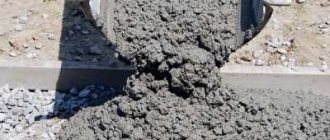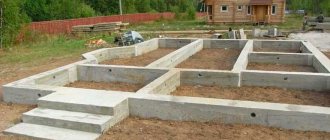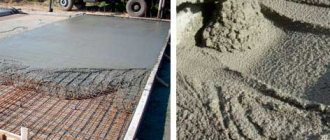Beton-House.com
Website about concrete: construction, characteristics, design. We combine the experience of professionals and private craftsmen in one place
Laying technologies
Self-compacting concrete is a rationally selected composition of components, resulting in viscous, highly mobile concrete that is compacted in structures under the influence of its own weight, without the use of any special equipment.
Self-compacting concrete mixtures, due to their own physical and mechanical properties, are capable of providing high density even when laid in densely reinforced building structures with complex geometric shapes (see video in this article).
- Classification
What is self-compacting concrete?
Self-compacting concrete (SCC, in English literature - SCC) is a highly mobile, non-separating concrete that spreads over the pit, fills the formwork and envelops the reinforcement without any mechanical effort. The flow of SCC is measured in terms of flow using the ASTM C 143 test. The flow (workability) of SCC typically ranges from 45.5 to 81 cm depending on project requirements. Viscosity, which is visually defined as the rate of spreading of the mixture, is an important characteristic of plastic SCC, which can be controlled at the mixing stage in order to suit the specific type of object being built.
WHY is SUB used?
Some advantages of using SMS:
- Can be placed faster, without mechanical vibration and with less leveling, which translates into savings in pouring costs.
- Improved and more uniform architectural surface with little or no remediation work.
- Easily fill obstructed and hard-to-reach areas. The ability to create structural and architectural forms and surfaces not available with conventional concrete.
- Increased envelopment of reinforcement and improved strength of interaction with it.
- Increased pumping ability.
- Increased uniformity of poured concrete due to reduced manual leveling work.
- Reduced labor costs.
- Acceleration of construction and, as a result, cost savings.
- A shorter mixer turnaround time allows the plant to more efficiently maintain the facility.
- Reduced or eliminated vibration to avoid or reduce noise levels, resulting in longer workdays in urban environments.
- Minimize the movement of mixers and pumps around the construction site.
- Increased safety on the construction site due to the elimination of compaction.
HOW IS SUB MADE?
Self-compacting concrete in its plastic state has two important characteristics: flowability and persistence. High flowability is usually achieved by adding water replacement additives (HRWRs) and reducing the volume of water in the mixture. Storability, or resistance to separation of a plastic concrete mixture, is achieved by increasing the volume of fine aggregate in the mixture (by increasing the content of the cementing component or using mineral fillers) and by using additives to increase viscosity. Such additives are especially useful when the ratio of aggregates cannot be changed. Proper distribution of aggregates in the mixture allows self-compacting characteristics to be achieved with less binder or additive consumption. Although SCC can be mixed with aggregates up to 38mm, it is easier to make and control with smaller aggregate sizes. Control of wet aggregates is critical to obtaining a quality mix. SCC typically has relatively more (cement) paste, less coarse aggregate, and more fine aggregate than regular mix.
It is important to ensure the spreadability of the mixture when unloading it at the construction site. High temperatures, long delivery times and delays at the construction site can cause reduced flow, negating the benefits of using SCC. Adding water on site does not always restore lost flowability, but can cause problems with the consistency of the mixture (not to mention problems with strength - approx. trans.)
Due to the potential for mixture leakage, it is not recommended to transport high flow SCC in fully loaded mixers. If this must be done, it is better to transport the reduced flow mixture and add water replacement additives (HRWR) directly on the job site. Care must be taken to maintain the shelf life of the mixture and to minimize clogging of the pump boom when pumping and placing in hard-to-reach areas. The formwork must withstand the high pressure of the mixture. In higher elements the SCC can be placed in lifts. Once the concrete is poured, it should not separate or release water.
By analogy with conventional mixtures, special additives can be used for self-compacting concrete to achieve certain characteristics at the design age. If a self-compacting mixture is designed with increased binder or fine aggregate, an increase in shrinkage volume may occur.
Cost of a cube of concrete for a foundation
When continuously pouring large-volume structures, it may be more profitable to order and deliver ready-made concrete. Of course, it will be a little more expensive than if you prepared the mixture yourself. Here you will have to pay for all work on manufacturing the product, loading, delivery to the site, and unloading.
Most likely, to fully automate the process, you will also need a concrete pump to supply large volumes of the mixture directly to the placement site. However, this option of filling the structure has many advantages:
- Concrete will be delivered exactly on time. But try to complete all work on installing and securing the formwork so that there is no delay. All deadlines must be calculated in advance. Delaying the mixer will be very expensive.
- At factories, the quality of manufactured products is checked by laboratory assistants, and the workers there are usually highly qualified.
- Very big savings in time and labor costs. Even if we calculate these two parameters, then almost always, with large volumes, it is more profitable to order finished products.
- With quick and continuous filling with a high-quality mixture, you will receive a structure that will meet all technological parameters, reliable, and with a long guaranteed service life.
The average cost of concrete in Russia varies greatly across individual regions. At the time of writing, the cheapest finished product was in the North Caucasus Federal District (2240 rubles per 1 cubic meter of M 250 grade concrete) , and the most expensive in the Siberian and Far Eastern Federal Districts, where the question “how much does concrete cost” can be answered with 4380 rubles per 1 m3 .
How much does a concrete machine cost? For Moscow and St. Petersburg, the calculation will be approximately as follows: A machine with a lifting capacity of 7 tons with a delivery no further than 10 km from the city, concrete grade M100, with gravel from 22,000 to 25,000 rubles. 9 ton car - about 30,000.
But it’s better, of course, to find out how much a cube of concrete for a foundation costs at actually operating enterprises in your area. The price of 1 cubic meter of concrete very much depends on the required brand of cement and the type of crushed stone, additives that increase frost resistance or resistance to chemical and biological compounds. The price lists of enterprises separately indicate:
- price of delivery within the city and over long distances;
- minimum order quantity (usually at least 5 cubic meters);
- cost of pouring concrete;
- nominal time for unloading the mixer after arriving at the site;
- the cost of hourly payment for possible downtime due to the fault of the customer.
Read the order agreement carefully, follow all the rules and you won’t have to pay extra.
HOW to test the SUB?
There are several procedures for testing the ductile properties of SCC. The flow test, using a conventional cone, is the most popular "field" test recorded by ASTM (American Society for Testing and Materials). The cone is filled with concrete without compaction, raised, and the spread is measured. The spread can range from 45 to 81 cm. Delamination resistance can be tested using the Visual Stability Index (VSI). This measurement is taken at the base whether there is water on the top layer or crowding in the center. Index values range from 0 for highly persistent to 3 for unacceptable persistence.
The viscosity of a mixture can be measured by flow testing with a cone. To do this, you need to measure the time it takes for the mixture to spread 50 cm from the moment the cone is lifted. This is called the T50 measurement and usually has a value of 2 to 10 seconds (although it is not clear what the value is for a self-compacting mixture with a completely acceptable spread value of 45 to 50 cm - approx. transl.). A higher T50 value means a more viscous mixture, more suitable for heavily reinforced objects and deep excavations. Smaller T50 values are suitable for cases where the mixture needs to spread over a long distance horizontally without obstacles.
Preliminary mixture evaluation uses the U-box and L-box tests, where concrete is poured into one part of the box, then the baffle is opened and the ability of the concrete to fill the second part of the box containing the reinforcement is measured. A variation of the cone test is the J-ring, where a reinforced structure is placed around the cone and the ability of the SCC to spread without delamination is measured as the cone is lifted. All of these tests measure the ability of the SCC to overcome dense reinforcement. Another standard test is the column test, which measures the coarse aggregate content at different heights of a cast column as an indicator of persistence (resistance to delamination).
Technology for preparing concrete for the foundation
You can manually mix a very limited amount of concrete in a trough. This work is too labor-intensive and this method is only possible if it is necessary to concrete a small structure. It also happens that concrete is needed in small volumes over a certain period of time. For example, tiles are made, columns are poured for the foundation. In such cases, kneading by hand is also suitable.
- First of all, the trough itself must be placed so that all the components are as close as possible . It’s better to carry ready-made concrete later than to go long distances with buckets of gravel or sand. A water hose with a tap should also always be at hand.
- Do not pour water into the trough immediately. First add the required amount of sand and cement. It will be much easier to mix all this in dry form. Moreover, the mixture should be homogeneous. Now you can add water little by little and stir (partially, but not the entire volume at once, this will only complicate the process, take away energy and the quality will be worse).
- Having received a solution with the consistency of sour cream, you can add gravel , but also in small portions and mix until smooth in parts and only at the end the entire volume. It is better to prepare concrete in small portions than a full trough at once. This will be easier for you, and the end result will be a homogeneous, high-quality mixture.
Equipment for mechanization of concrete preparation
For concreting large-volume structures or those requiring a continuous process of laying concrete at home, concrete mixers are used. This greatly simplifies and facilitates the process of preparing the mixture. These units are loaded manually, but there is no need to mix.
In Russia, five types of mixers are used. The technology for producing the mixture is slightly different from manual preparation in terms of the sequence of loading the components. Here are some rules and regulations that can be applied to all types of concrete mixers:
- Place the agitator as close to the sand and gravel piles . Cement and water should also be nearby.
- The drum walls and blades must be thoroughly cleaned. You can even coat all surfaces with machine oil.
- It is not allowed to use units with broken or bent blades that cling to the drum walls.
- Connect and check idle operation. The unit must operate steadily, at its normal speed and not swing.
- Pour in some water, turn on the mixer and add cement in small portions This will set the basis for preparing the mixture and will facilitate the mixing process itself. Do not pour cement in large portions, otherwise lumps will form.
- After you have received a portion of cement milk, you will lubricate all surfaces with it. Now the remaining components will not stick to the surfaces and you can add sand and gravel evenly, in small portions, at the same time.
- Water and cement are added little by little, but constantly as the drum fills. During the entire mixing process, it is necessary to monitor the homogeneity of the mixture and prevent separation of the components. If you notice lumps, wait a little without turning off the unit itself.
- Do not fully load the concrete mixer. This will keep your unit operating longer. But the rotation of the drum and auger blades must be continued constantly until the mixture of the required consistency is completely homogeneous .
- After each cycle, the unit must be washed and cleaned . At the end of the work, this must be done especially efficiently, since the hardened concrete will be much more difficult to remove next time.
If you are building a house, then to make the work easier you will need to buy a concrete mixer. This is not so expensive, but it will greatly facilitate the entire construction process and preserve your health. Below is a table showing the most budget and popular concrete mixers today.
| Concrete mixer brand | Motor Power (W) | Drum volume (liter) | Mixture volume (liter) | Weight, kg) | Rotation speed (rpm) | Price, rub) |
| Kraton Bectone 130 | 500 | 115 | 80 | 52 | 26 | 8785 |
| Kraton SM-65 | 400 | 65 | 46 | 25 | 27.5 | 6600 |
| Whirlwind BM-120 | 450 | 120 | 70 | 31 | 27 | 9920 |
| Limex 125 LS | 700 | 140 | 90 | 58 | 28 | 11400 |
| Enkor 126/550 | 550 | 125 | 75 | 52 | 29 | 8400 |
| Sturm CM 1907C | 250 | 70 | 42 | 70 | 30 | 7530 |
| Iola-K IK-63 | 250 | 63 | 23 | 25 | 26 | 5000 |
| Hammer—Hammer | 250 | 70 | 32 | 46.2 | 30 | 6450 |
HOW to order and clarify the characteristics of the SUB?
When ordering and/or specifying SCC characteristics, the final application of the concrete should be taken into account. Concrete manufacturers usually have developed proportions depending on the application. The required flowability is based on the type of structure, pouring method, complexity of the formwork configuration and reinforcement. ACI 237 is finalizing a document that will provide recommendations for spreading mixtures depending on the end application. This will make it possible to achieve self-compaction easily, with the required stability of the mixture and at a minimum cost. The requirements for hardened concrete should be drawn up by a professional based on the load requirements of the structure. In most cases, the strength requirements are the same as those for conventional concrete. Depending on the requirements for each specific project, specific requirements for SMS can only be put forward after the requirements for concrete in a plastic and hardened state are clearly defined.
How much concrete is required to pour a foundation?
To pour a strip foundation for building a house, it is quite simple to calculate the required amount of concrete. We multiply the average height of the foundation by its height and then by the entire length. However, with this calculation, all figures will be averaged.
The height depends on the topography of the base and, if the upper mark is made by a level and should be the same everywhere, then the lower one can vary. Usually, in a simple calculation, the average indicator is taken.
The width is the same everywhere, but when constructing the formwork you cannot require millimeter precision. And during concreting and vibrating, the formwork may burst somewhere. Therefore, it is necessary to pay special attention to the quality of the formwork fasteners.
In practice, the resulting result of the required volume of concrete must be multiplied by a factor of 1.2. If you order concrete, then take 30 percent more. However, immediately provide for the possibility of laying the excess, for example, on paths, a foundation for a fence, or on other structures that can be poured with a reserve for the future.











